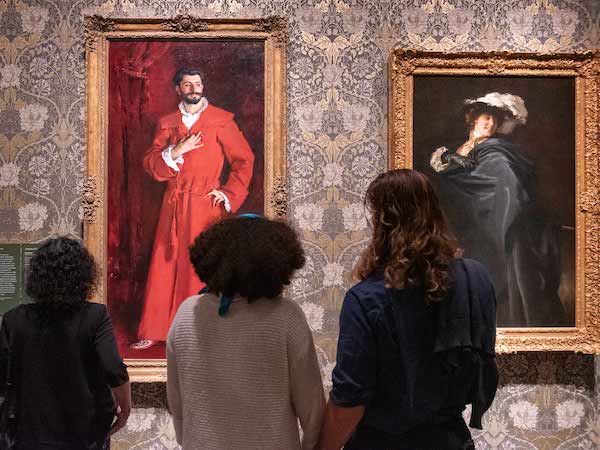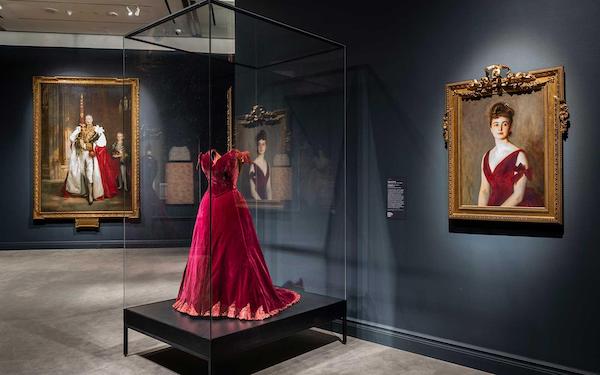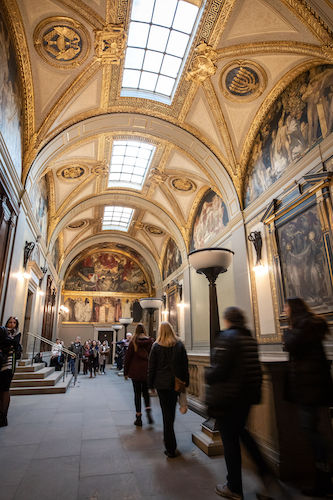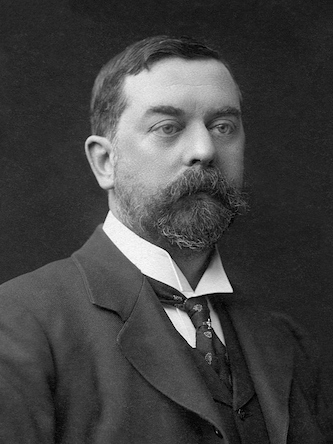Visual Art Commentary: Boston and Sargent, For Better, For Worse.
By Trevor Fairbrother
Boston’s veneration of John Singer Sargent is awkwardly implicated in the city’s habit of denouncing modern art.

A shared photo posted on the MFA’s Facebook page of a visitor to the Fashioned by Sargent exhibit.
The liaison between Boston’s cultural establishment and the expatriate artist John Singer Sargent (1856-1925) was fruitful in its day and lives on as a heritage industry. In 1888 the St. Botolph Club hosted his first-ever solo exhibition and debuted the eccentric portrait of Isabella Stewart Gardner sheathed in her black Worth gown. In 1956 the Museum of Fine Arts organized Sargent’s Boston to celebrate the 100th anniversary of his birthday; then it gave him the blockbuster treatment in 1999, 2015, and 2023. Sargent’s mural decorations for the Boston Public Library, the Museum of Fine Arts, and Harvard University are constant reminders of his eminence during the heyday of Wasps and Brahmins.
The objective of the MFA’s latest extravaganza, Fashioned by Sargent, was to discredit the supposedly common belief that wealthy clients bossed the portraitist around: the curatorial tactic for demonstrating his power over sitters was to show his active involvement in costuming. Visitors followed a winding path punctuated by lavish clothes displayed in vitrines. The installation made no effort to demonstrate the artist’s development. The works were grouped nonchronologically as illustrations of such topics as “Portraiture and Performance,” “Fashioning Power,” and “Sporting with Gender.” The most rewarding moments were juxtapositions of five period garments with five Sargent paintings of women wearing them: one opera cloak, two evening dresses and two stage costumes.
In his review for the Boston Globe Murray Whyte objected to the decision to craft a “frothy blockbuster of unabashed prettiness.” The critic admitted in an honest aside that he typically found Sargent to be a “talented-but-shallow” artist and he’d hoped that the new show would change his assessment. In the New York Times Karen Rosenberg praised the way the period clothing focused attention on Sargent’s “fabric-flaunting brushwork.” She noted that Fashioned by Sargent would please fans of HBO’s TV series The Gilded Age and agreed with the exhibition’s suggestions that Sargent deployed clothes to “play up [a subject’s] outsider status” when portraying suffragist women, flamboyant men, and Jewish families.
Mary Sherman argued in the Arts Fuse that the exhibition was slippery with regard to the grim politics of Sargent’s world, including imperialism, white supremacy, and pernicious polarization. The MFA’s wall labels only alluded (“at whisper level”) to the questionable ideals of many of his patrons, who were the new Anglo-American ruling class. In the Wall Street Journal, Eric Gibson called the show a “muddle-headed effort” skewed by an overthought preoccupation with identity-driven marketing. He advised visitors to “skip” the labels because they pigeonholed Sargent as a Svengali-like artistic director.
In the Washington Post Sebastian Smee professed indifference to the exhibition’s “animating question” about Sargent being in control of his portraits. The review became an occasion to applaud “the wild beauty in Sargent’s virtuosity.” Smee’s enthusiasm recalled historic commentators who viewed the portraitist as a demonic artiste in the Paganini tradition. At times his prose rivaled the painter’s brio: “In Sargent’s hands, a black opera cloak … can come to resemble an undulating coalpit as if painted by Velázquez. A long string of pearls seems to slide down [a] voluminous pale pink dress … like a glistening waterfall seen from a hot-air balloon.”

Image cooked up to market to the desired demographic for “Fashioned by Sargent.” Photo: MFA
Fashioned by Sargent arrived during a rolling anniversary that is receiving virtually no attention: the centennial of Sargent’s last hurrah as a Boston muralist. Beginning in 1916, he was engrossed by contractual obligations for decorations at the Boston Public Library, the Museum of Fine Arts, and Harvard University’s Widener Library. He made five visits to advance those schemes: 1916-18; 1919-20; 1921; 1922; and 1923-24. During these years he probably spent as many nights in local hotels as in his London residence.
The BPL planted the seed for all this in 1890 by inviting him to decorate a third-floor hall in its future home in Copley Square. His subject was the spectrum of religious practice, from polytheistic pagan idolatry to monotheistic Judaism and Christianity. Sargent had completed one half of his commitment when the palatial building opened in 1895. After petitioning to augment the scope, he delivered new sections in 1903, 1916, and 1919.
Sargent’s second mural project was the rotunda of the MFA. Its unveiling in 1921 prompted a contract to extend the mythologically themed decorations over the adjoining grand staircase. The third scheme was a two-panel memorial to Harvard University men who had recently fought and died in Europe. It was installed in Widener Library late in 1922. While Boston is the only city in the world with murals by Sargent, London museums own two monumental quasi-mural works made as official British commissions: Gassed (1919), a soulful vista of wounded soldiers, went on permanent display at the Imperial War Museum in 1920; General Officers of the Great War (1922), a stiff full-length portrait of 22 uniformed men, promptly entered the collection of the National Portrait Gallery.

The devil in the red cape? A look at the “Fashioned by Sargent” exhibition. Photo: MFA
Sargent died of a heart attack in London in 1925 on the eve of a trip to install his final canvases for the MFA. Soon thereafter, the Boston Symphony Orchestra and its conductor Serge Koussevitzky commemorated him by playing the funeral music from Wagner’s Götterdämmerung. Thomas Fox, the artist’s friend and architectural advisor, directed the installation of the staircase murals at the museum. The unveiling coincided with the opening of a memorial exhibition with 256 works.
The artist assumed that his murals would be the crowning achievements of his life’s work because time-honored hierarchies ranked architectural decoration well above portraiture. But, as early as 1917, there was a nucleus of dissent: Forbes Watson, a well-to-do Bostonian living in New York, published a stinging critique titled “Sargent – Boston – and Art” in Arts and Decoration. Watson identified himself as a Modernist, named Cézanne as his touchstone, and declared the murals at the BPL lifeless, artificial, and out of touch. A comprehensive study of Sargent published in 1970 relegated discussion of the murals to an addendum. The author, Richard Ormond, deemed the BPL project “no better and no worse than many contemporary decorative works of the same kind,” and declared the Harvard murals “fairly insipid and banal.”
In 2022 the BPL devoted a lecture series to “new interpretations” of its Sargent murals. The announcement indicated that program would mark “the centenary of the (later struck down) 1922 Massachusetts legislative bills to remove a contentious portion of the mural titled Synagogue.” By focusing on that controversy, the lectures would raise awareness about the “interpretation and stewardship” of public art that is “potentially offensive.” In the panel discussion that closed the series, Rabbi Bernard Mehlman called Sargent’s Synagogue a “pretty demeaning image.”

John Singer Sargent’s painting Synagogue is in the foreground, then the empty space that was never completed, and the Church in the distance. Taken in Boston Public Library’s Sargent Hall in 1916. Photo: Creative Common
Here is an overview of the dispute. In 1919 Sargent installed his two shrine-like paintings Synagogue and Church. The allegorical image of Judaism showed a crumpled, blindfolded hag with a broken scepter and falling crown; that of Christianity presented the radiant, majestically enthroned Virgin Mary. Outraged Jewish leaders argued that a secular public building was not an appropriate setting for the display of contrasting emblems that fueled anti-Semitism in centuries past. Sargent let it be known that he had emulated Medieval works one could see in European cathedrals.
In January 1922, Colman Silbert introduced a bill in the Massachusetts Legislature requesting the removal of Synagogue. The bill passed and the Legislature required that the painting be placed with the State Department of Education. Over a year later department officials reported that they were disinclined to burden a state school with a “costly original painting” that might “provoke sectarian or religious controversy.” Silbert’s bill was repealed in April 1924. Meanwhile, Sargent had stalled work on Sermon on the Mount, the massive picture intended for the space between Synagogue and Church. In July 1924 the BPL’s director told a professor at Syracuse University, “I understand that Mr. Sargent is not disposed to paint a picture for the central panel; at all events no beginning has yet been made by him.” It seems that the artist chose to leave his BPL mural cycle artistically and programmatically incomplete.
Boston’s veneration of Sargent is awkwardly implicated in the city’s habit of denouncing modern art. In 1913, when the Copley Society hosted the so-called Armory Show, Bostonians were shown a strong selection of works by the most radical European artists. The project was an unprecedented American endeavor to showcase the international “new spirit” in art. Many viewers in New York and Chicago gamely tackled the Post-Impressionist, Fauve, and Cubist art. In Boston, however, the prevailing reaction was a high-handed insistence on the need to protect and defend established notions of classical beauty.

A group of visitors in Sargent Hall admiring the restored Sargent murals in the Boston Public Library. Photo: BPL
Horrified by a complete break with the past, most Bostonians instinctively embraced Sargent’s values in their efforts to repel the “ultra-modernists.” Two years earlier, Sargent had informed the American magazine the Nation that he had a low opinion of Post-Impressionism. In the Boston Evening Transcript William Howe Downes derided the “alleged works of art” in the Armory Show and declared, “Matisse is unquestionably a mountebank of the first water, and there is not any reason in the world for taking him seriously.” When the show closed, Downes wrote, “It is quite apparent that the revolutionary productions of these eccentric people have not been taken at all seriously.” (This is sad in hindsight, because Sargent had made waves in Boston in the 1880s as a rather modern Frenchified painter enamored of Edouard Manet and Claude Monet.)
In 1926 a young art history professor wrote an article for the Harvard Crimson, titled “Boston Is Modern Art Pauper.” The author, Alfred Barr, complained that local museums had failed to collect paintings by Gauguin, van Gogh and Cézanne. He stated, “In Boston, the development of 19th-century painting is half-heartedly illustrated through the Impressionist period. But after that we find only such fashionable virtuosos as [Ignacio] Zuloaga and Sargent.” The Boston Daily Globe deemed Barr’s criticism to be just and admissible and declared the problem insurmountable because the institutions were plagued by lingering strains of Puritanism. (In 1929 Barr became director of the newly founded Museum of Modern Art in New York City.)
In 1955 Charles Merrill Mount hoped to save the fallen idol with John Singer Sargent: A Biography, but responses were lukewarm. Bernard Berenson wrote a pithy diary entry about the book. The renowned Boston-born Jewish art historian, then in his 90s, noted that he had just read a “stupidly ignorant” magazine review of a “very poor book on Sargent.” Berenson fully grasped the impasse. He regretted the “contemptuous indifference” that younger people were showing, but he was equally dismayed by the gullibility of the Anglo-American establishment that had lionized Sargent for decades. He had a hunch that a reasoned, less sensational interpretation would eventually transpire: “I prophesy that he will be appreciated at his value.”
For Berenson, to see Sargent “at his value” required frankness. He thought that Sargent’s technique was fine, that he had a gift for the “sensory revelation of character,” and that his watercolors were “always delightful.” But he found the murals wanting, and wrote, ”Failed utterly as a decorator. As ‘murals’ I know of nothing less appropriate to their walls than his in the Boston Public Library.” Sargent was a bachelor, which led Charles Merrill Mount to harp on the “tragedy” of his failure to find a wife. The biographer also noted that Sargent was a large, strong, and virile man who would never be “taken for an example of the intellectualized homosexuality notable among the artists of London.” Berenson’s rejoinder to all this was pithy and pointed: “Was he a lover of women?”

John Singer Sargent in 1903. Photo: Wiki Common
It took decades to recuperate Sargent’s standing. When the Whitney Museum orchestrated a major retrospective in 1986 Time magazine’s critic Robert Hughes wrote a passionately conflicted review. He declared it unacceptable to dismiss the artist as a “flashy bore” — one just needs to realize that he was “an unreflective spectator [who] saw the world as a string of motifs and rendered its surface with sparkling bravura.” The 1892 portrait of Lady Agnew had the right bravura to make Hughes swoon: “[Sargent] brought such excitement to his scrutiny of light and shade on a knotted lilac sash, of skin gleaming through voile, and of delicate flesh so strongly modeled as to convince you that nothing else was more worth looking at.”
When Sargent’s critical reputation plummeted in the mid 20th century it remained strong in Boston. A network of stakeholders still promotes him, especially at the MFA. In 1999, after completing the restoration of its mural scheme, the director stated: “The hub of the Museum is once again what the institution’s founders and Sargent intended it to be: one of the most handsome, and indeed inspiring, decorative interiors in America, a space that both welcomes the visitor in a suitably majestic fashion and pays tribute to the Museum’s mission to honor and preserve the arts.” The MFA owns almost 600 works by Sargent in all media, and claims to have the world’s most comprehensive collection of his art. It made its most recent purchase in 2023: an oil sketch of Sargent’s sister Violet as a little girl, painted in Paris in the 1870s. The beat goes on.
Trevor Fairbrother worked for the MFA from 1981 to 1996, first in the Department of American Painting, then in the Department of Contemporary Art. He wrote about his early contributions to Sargent studies in the Isabella Stewart Gardner Museum’s publication Boston’s Apollo: Thomas McKeller and John Singer Sargent (2020). © 2023
Tagged: Boston Public Library, Fashioned by Sargent, John Singer Sargent, Sargent Hall

How great to have a learned Sargent expert offer such an up-to-date, comprehensive essay. A coup for The Arts Fuse!
Ahhh..Sargent….
It is a rare treat to read this meticulous, scholarly essay by Trevor Fairbrother, an unabashed advocate for the artist. In particular it was enjoyable and laudable to read his pithy critiques and summaries of the critics and their stances. There was the blustering now passed, Australian, Robert Hughes. Fellow Australian, Sebastian Smee, formerly wrote for the Globe and now for the Washington Post. They are and were infatuated with the scent of their own prose. That’s evident in Smee’s Sargent and more self indulgent and fatuous in a self absorbed piece on Rothko in Paris which had little to do with the artist and everything about dodging a rainy day in Paris. I have always found Trevor’s British heritage key to his deft navigation of the taste of Bostonians in the Gilded Age. Those refined values applied to his contributions to the emerging contemporary department of the MFA. Like minded critics, gallerists, and curators admired his exhibitions and acquisitions. He moved on rather than answering to the vulgarian Malcolm Rogers. One wonders what if?
Brilliantly explained!
Many thanks for your comments, Charles. I never got to work with Malcolm Rogers on Sargent. No one there was interested in me as a Sargent scholar after 1988, when I joined Kathy Halbreich in the Department of Contemporary Art. Rogers didn’t arrive until 1994. During that transitional period, I spoke more frankly about Sargent. In the preface of my 1994 monograph I wrote, “Sargent’s oeuvre is bloated by mediocre and lackluster works in which the performance seems contrived and the image lacks his characteristic certainty and vitality.” Before that I ‘d been undiplomatic about the 1904 full-length titled “Charles Stewart, Sixth Marquess of Londonderry, Carrying the Great Sword of State at the Coronation of Edward VII.” Writing for Arts Magazine in 1987 I stated, “Here Sargent is at his worst – trapped in the position of the painter of the ruling classes, called in to commemorate not just a face but yards of trappings.”
My historic bellyaching over the Charles Stewart portrait didn’t keep Malcolm Rogers from purchasing it for the MFA in 2003. By then, Architectural Digest had published photos of it hanging in the lavish apartment of financier Henry Kravis, designed by Vincent Fourcade during the go-go eighties. The MFA touted it as the first Sargent full-length oil portrait of a man to enter the collection. What is it about Boston and Sargent?
We agree on the Stewart portrait and the vulgarian taste of Malcolm Rogers. What stuck me at the time was why anther Sargent when there are so many other needs?
As a journalist, retired Columbia professor and photographer, I loved the new exhibit. Sargent’s poses, costuming and lighting have become the model for most of the past century’s formal photographic portraiture. Oddly enough, the great impressionists and post-impressionists’ works have not.
As a teenager in high school, I worked in the Science and Technology section of the Boston Public Library and climbed the main staircase from what was then the library’s front entrance, all the way to work on the third floor. The Sargent Gallery at the top was my reward for the climb.
File this “review” under the sodden pile of critical old reviews trashing whatever great artists do, in whatever styles amuse and move those artists.
Are you the Steve Ross who uses to work at MBA Communications?
I loved the Sargent exhibition. Thrilling. Went twice. Would go again if it weren’t for Covid.